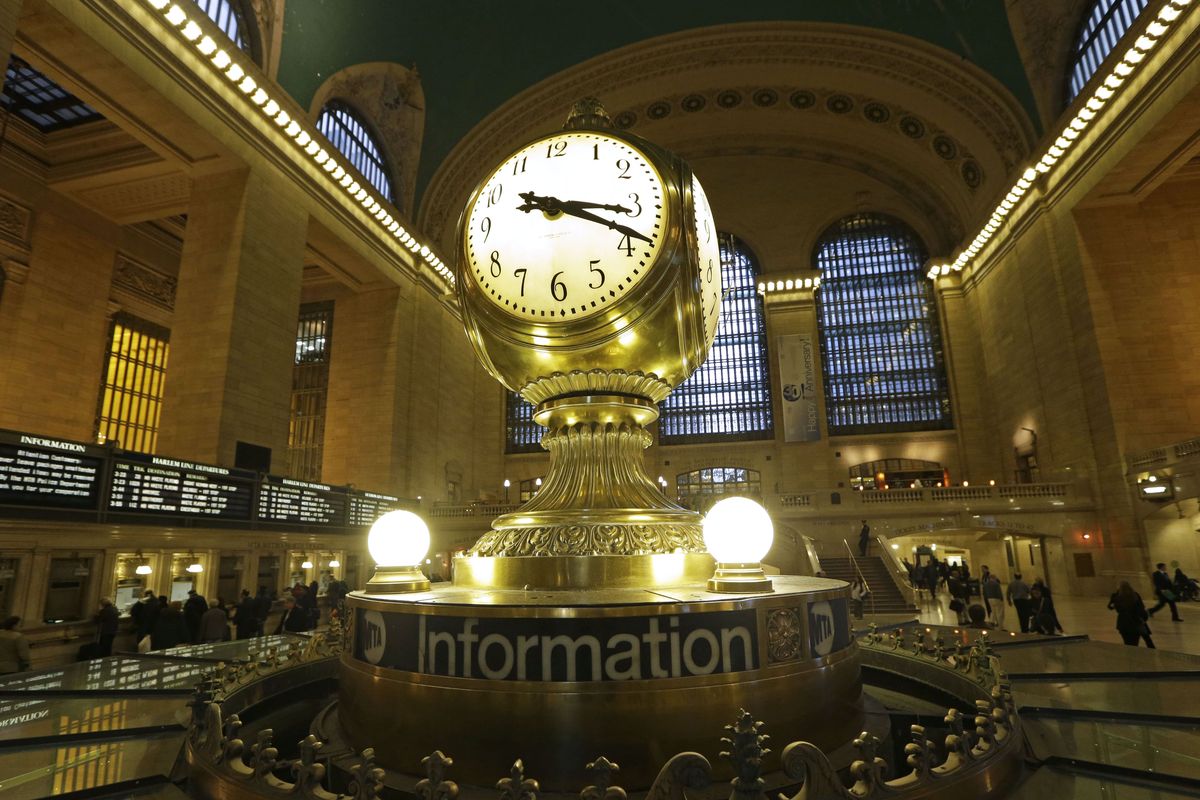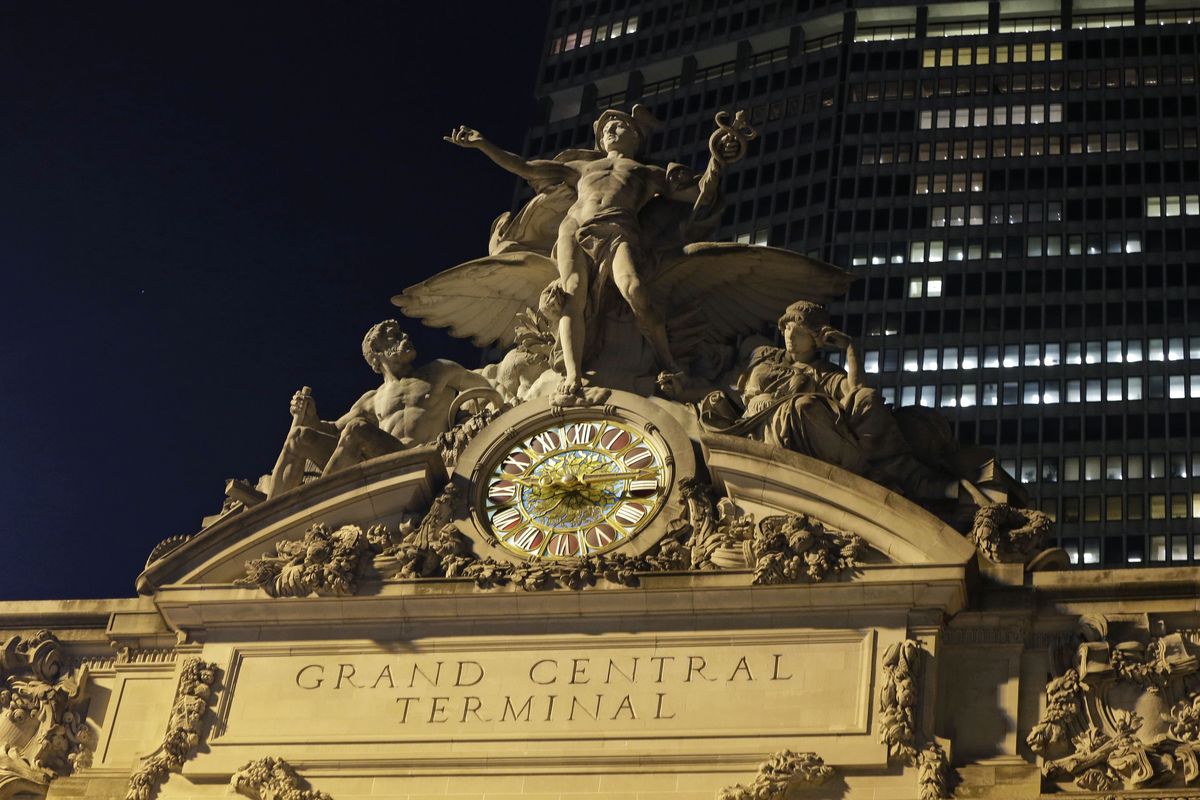Celebrated New York train station turns 100 years old
Grand Central, a testament to the value of preserving historic landmarks
The famous opalescent clock keeps time at the center of the main concourse in Grand Central Terminal in New York. (Associated Press)
NEW YORK – Grand Central, the country’s most famous train station and one of the finest examples of Beaux Arts architecture in America, turns 100 on Feb. 1. Its centennial comes 15 years after a triumphant renovation that removed decades of grime and restored its glittering chandeliers, cathedral windows and famous ceiling depicting a night sky.
The building’s survival is also a testament to historic preservation: The landmark was saved from demolition in the 1970s thanks to a battle spearheaded by Jacqueline Kennedy Onassis that went all the way to the U.S. Supreme Court. In 1978, the court ruled that cities have the right to protect historic buildings, even if that limits the owner’s ability to develop or sell the property. The decision legitimized preservation efforts around the country.
Grand Central was an engineering wonder when it opened in 1913, with trains flowing seamlessly over 67 subterranean tracks and thousands of people departing and arriving daily from around the country. Purists note that it’s actually not a station, but a terminal, where trains stop and start their routes rather than passing through. But it’s always been much more than a place to get on or off a train: It’s a spectacular public space with marble floors, tiled arches, ornate staircases and even sculpture inspired by Greek and Roman mythology.
“The whole point was that regular people would feel like they were in a cathedral,” said Jessica Halem, spokeswoman for the Municipal Art Society.
The terminal also symbolized “the great era of transportation,” said Mickey Jacob, president of the American Institute of Architects. “The grandeur and elegance coming into this space suggested the great adventure beyond.”
But the era of luxurious long-distance train travel began to fade after World War II. By the time Grand Central’s restoration began in the late 1990s, the roof leaked, bathrooms were unusable, pigeons roosted in corners, and the windows and ceiling were dark from cigarette smoke. On Christmas Day 1985, a homeless woman died in the waiting room. So many homeless people lived in the hallways and tunnels that the U.S. Census Bureau sent in a special team in 1990 to count them.
Today the only trains in Grand Central are run by Metro-North Railroad to the city’s northern suburbs. But the railroad’s 275,000 passengers are not the only ones using Grand Central. It remains the largest train station in the world, and it is also one of the most-visited buildings in the world, with 750,000 people passing through daily, including tourists and commuters using the onsite New York City subway station.
Some of those passing through are shoppers. Grand Central has become an attractive location for dozens of high-end retailers, from a jeweler to an Apple store. And while the iconic Oyster Bar continues to dish up raw oysters, as it has since 1913, the terminal’s restaurants and bars now include Michael Jordan’s The Steak House N.Y.C. and the elegant Campbell Apartment, which was once the private apartment and salon of a 1920s tycoon, John W. Campbell.
If you’re visiting Grand Central for the first time, make a point of contemplating its famous features: the tall windows, grand staircases, chandeliers, and four-faced clock at the central information booth. The clock has been a meeting point for New Yorkers for generations and now serves as a symbol of the centennial.
Just outside the Oyster Bar lies the whispering gallery. Press your face into a corner and your whisper can be heard by someone in a corner across the way.
A plaque honoring Onassis’ work in saving the terminal can be found in Vanderbilt Hall. Onassis was the widow of President John F. Kennedy, and their daughter, Carolyn Kennedy Schlossberg, is expected to attend a centennial launch event in Grand Central on Feb. 1.
One of the terminal’s best-known features is the ceiling painting of the zodiac, with gold-leaf constellations and twinkling light bulb stars. But a commuter in 1913 noticed that the zodiac was backwards – it’s a mirror image of how the sky actually looks. Among the explanations given: It was painted from God’s point of view, above the heavens.
While you’re staring up, look for a hole in the ceiling near the Pisces constellation that marks the spot where cables secured a rocket ship displayed here in 1957. And in the ceiling’s northwest corner, near the stationmaster’s office, there’s a black smudge. That’s the color of the ceiling before the renovation.
Other fun facts for Grand Central cognoscenti: The times listed on a board for Metro-North trains are a minute earlier than actual departures, to give passengers precious seconds to board in time. The information booth’s brass kiosk hides a spiral staircase connecting to a booth a floor below. And there’s a secret train platform a few blocks away beneath the Waldorf-Astoria Hotel, where U.S. presidents visiting New York usually stay. (The hotel is north of Grand Central but the terminal’s subterranean footprint extends from 42nd to 97th streets.) President Franklin Delano Roosevelt, whose legs were paralyzed from polio, used the platform to exit a train unobserved. A waiting car took him into the Waldorf garage through an underground passage.
On a recent evening, those admiring the terminal included a group of docents from the Municipal Art Society who were training to give public tours. Their varied reasons for becoming volunteer guides show how passionate many New Yorkers remain about Grand Central, 100 years after it opened.
Robert Depczenski said his interest in telling Grand Central’s story to visitors was inspired in part by the destruction in the 1960s of another beautiful train station – the original Pennsylvania Station, which was torn down to make way for Madison Square Garden and the current Penn Station. Another volunteer tour guide, Liza Whiting, said she enjoys letting visitors in on Grand Central’s fun secrets, like the whispering gallery, the hidden staircase and the black spot on the ceiling. And Diane Pagen decided to become a tour guide because of a personal experience: During a time when she struggled with depression, visiting Grand Central always lifted her mood.
Those who’ve felt Grand Central’s magic say it’s no surprise that it still inspires strong emotion. The building is not only “grand and elevating with the Beaux Arts architecture representing the height of high culture,” said Roberta Lane, senior New York field officer for the National Trust for Historic Preservation. “It also just really appeals to people on a personal level.”

